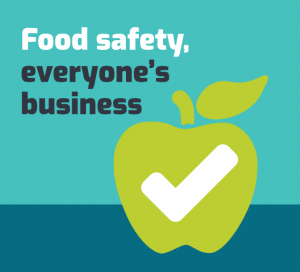This weekend (7 June) marks the second annual World Food Safety Day, established by the World Health Organisation (WHO) and Food and Agriculture Organisation of the United Nations, and supported by food regulators, food producers and food lovers all over the world.
Recent events, such as the COVID-19 global pandemic, highlight just how important food safety and food security are to consumers. Everyone has the right to sufficient and nutritious food that is safe to eat. And while there is no evidence to suggest that COVID-19 can be transmitted by food, WHO estimates that more than 600 million people fall ill and 420,000 die every year from eating contaminated food.
 Unsafe food (containing harmful bacteria, viruses, parasites or chemical substances) causes more than 200 types of illness or disease – ranging from diarrhoea to cancers. Yet food safety is often taken for granted, especially in developed countries like Australia. It is invisible until you get food poisoning.
Unsafe food (containing harmful bacteria, viruses, parasites or chemical substances) causes more than 200 types of illness or disease – ranging from diarrhoea to cancers. Yet food safety is often taken for granted, especially in developed countries like Australia. It is invisible until you get food poisoning.
Unsafe food not only impacts an individual’s health and wellbeing but can have more severe consequences for local communities and countries as a whole. Unsafe food creates a vicious cycle of disease and malnutrition, particularly affecting infants, young children, the elderly and sick. Foodborne diseases impede socioeconomic development by straining health care systems, and harming national economies, tourism and trade.
With food supply chains now crossing multiple national borders, good collaboration between governments, producers and consumers is essential to ensuring food safety and protecting public health. This international World Food Safety Day is an opportunity for all of us to strengthen our efforts. WHO explains below the key roles and responsibilities we each play in keeping food safe.
We all play a role in food safety
1. Ensure it’s safe
Governments work to ensure safe and nutritious food for all.
Governments play a critical role in ensuring that we can all eat safe and nutritious food. Policy makers work to promote sustainable agriculture and food systems, fostering multi-sectoral collaboration among public health, animal health, agriculture and other sectors. Food safety authorities manage food safety risks along the entire food chain, including during emergencies.
2. Grow it safe
Agriculture and food producers adopt good practices.
Good farming practices ensure a sufficient supply of safe food at a regional, national and global level. As food production systems transform to adapt to changing conditions, farmers must carefully consider optimal ways to address potential risks to ensure that food is safe.
3. Keep it safe
Business operators make sure food is safe.
Preventive controls can address most food safety problems. Everyone involved in food operations – from processing to retail – must ensure that food safety risks are identified, evaluated and controlled in order to protect public health. Additionally, good processing, storage and preservation can help retain nutritional value and food safety as well as reduce post-harvest losses.
4. Eat it safe
Consumers have a right to safe, healthy and nutritious food.
Consumers need access to timely, clear and reliable information about the nutritional value and disease risks associated with food to be able to make healthy choices. In addition, they must follow good food safety practices in the home to keep food safe. This includes washing their hands thoroughly before and after touching food, avoiding cross-contamination between raw and cooked foods, and storing or cooking foods to the correct temperature (chilling food at 5oC or lower, or cooking food to 60oC or hotter).
5. Team up for safety
Food safety is a shared responsibility.
The diverse group that share responsibility for food safety – governments, regional economic bodies, UN organisations, development agencies, trade organisations, consumer and producer groups, academic and research institutions and private sector entities – must work together on issues that affect us all, globally, regionally and locally. Collaboration is needed at many levels – across sectors within a government and across borders.
Food safety is a shared responsibility from production to consumption
Food safety is everyone’s responsibility and therefore everyone’s business. Today, food is processed in greater volumes and distributed over greater distances than ever before. Widespread collaboration and contributions of all actors in the food supply chain, as well as good governance and regulations, are essential to food safety.
Get involved in World Food Safety Day!
 Whether you’re growing food, producing food, selling food, or preparing food in your own kitchen – share with us on social media how you’re contributing to a safe food supply chain.
Whether you’re growing food, producing food, selling food, or preparing food in your own kitchen – share with us on social media how you’re contributing to a safe food supply chain.
Use the hashtags #WorldFoodSafetyDay and #SafeFood so we can see your posts.
